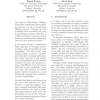Free Online Productivity Tools
i2Speak
i2Symbol
i2OCR
iTex2Img
iWeb2Print
iWeb2Shot
i2Type
iPdf2Split
iPdf2Merge
i2Bopomofo
i2Arabic
i2Style
i2Image
i2PDF
iLatex2Rtf
Sci2ools
COLING
2008
2008
Choosing the Right Translation: A Syntactically Informed Classification Approach
One style of Multi-Engine Machine Translation architecture involves choosing the best of a set of outputs from different systems. Choosing the best translation from an arbitrary set, even in the presence of human references, is a difficult problem; it may prove better to look at mechanisms for making such choices in more restricted contexts. In this paper we take a classificationbased approach to choosing between candidates from syntactically informed translations. The idea is that using multiple parsers as part of a classifier could help detect syntactic problems in this context that lead to bad translations; these problems could be detected on either the source side--perhaps sentences with difficult or incorrect parses could lead to bad translations--or on the target side--perhaps the output quality could be measured in a more syntactically informed way, looking for syntactic abnormalities. We show that there is no evidence that the source side information is useful. However, a targ...
Choosing | COLING 2008 | Computational Linguistics | Difficult Problem | Multi-Engine Machine Translation |
| Added | 29 Oct 2010 |
| Updated | 29 Oct 2010 |
| Type | Conference |
| Year | 2008 |
| Where | COLING |
| Authors | Simon Zwarts, Mark Dras |
Comments (0)

